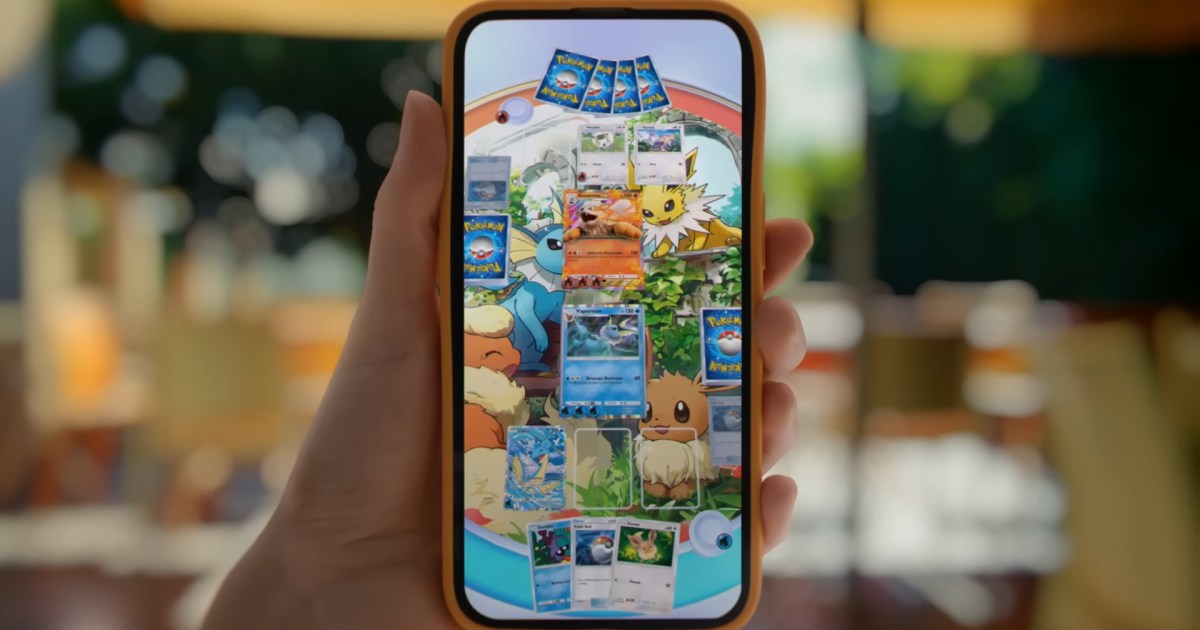What’s sure to be mobile gaming’s next big thing is here. Pokémon Trading Card Game Pocket is out now and it brings the classic tabletop deckbuilding game to your phone. It’s a free app that lets players open booster packs, collect cards, and play a streamlined version of the card game. On top of that, it’s full of social hooks and ways for players to show off their favorite cards. It’s about as much of a slam dunk as you could imagine for a mobile game, to the point where I’m surprised it’s taken The Pokémon Company this long to make it.
Nostalgia is an easy path to victory, but does that make for a good game? Based on my time with it so far, I can see some immediate appeal that’s sure to keep me logging in consistently for at least a few weeks. It’s the kind of free download that comes with a big red buyer beware, though. This is a game designed to vacuum up money in ways that can feel a bit uncomfortable. If you’re the kind of person who gets impatient anytime you’re presented with a timer, download it at your own risk.
Gotta collect ’em all
Pokémon Trading Card Game Pocket essentially looks to capture the full experience of the Pokémon trading card game and stuff it into a mobile app. In that sense, it’s a success. As soon as I boot it up and create my account, it quickly throws a five-card booster pack my way that I tear it open by swiping the screen. All the excitement I felt as a kid doing the same with real packs flooded in instantly. Just as I did back then, I find myself marveling at the art. Classic cards from my youth appear here, including the elegant Hitmonchan card I treasured as a kid, but I’m just as enamored with the art I’ve never seen. When I pull a card that features a top-to-bottom art spread showing Digletts burrowing through the card, I’m hooked.
That’s the simple thrill of Pokémon Trading Card Game Pocket. It captures what now feels like the fading joys of baseball card collecting, giving players a bounty of toys they can show off to their friends. It’s a very social-focused game in that sense, as I can fill up my friend list, create display boards for others to see, and battle online. More features like trading are in the works too. Perhaps my favorite touch here is Wonder Pick, a feature that lets players pick a random card from someone else’s pull. When I woke up this morning, I saw that I could try to pull from my girlfriend’s most recent pack, which contained a shiny Dragonite card. I’m incentivized to add more friends, keep track of what cards they have, and get rewarded for doing so.
In its opening tutorials, it may seem like there’s not much substance to it all. It can feel like a game that’s just about opening cards, as if it was originally built out as an NFT experiment that was reworked as a traditional game after the trend ended. That feeling fades a bit when hitting Level 3, where players unlock battling. Here, I can make a 20-card deck and face off in bite-sized fights either in a suite of computer-opponent scenarios or in online battles. As far as adapting the tabletop game to mobile goes, Pokémon Trading Card Game Pocket delivers.
The key to this version is that players don’t need to fill their decks with energy cards. That resource is auto-generated on each turn and can be applied to the monsters placed on my bench. Instead, my focus is merely on dropping down Pokémon cards, hitting opponents with attacks once I’ve accrued enough energy to trigger their attack, and evolving them when I’m able to do so. Type weaknesses, status effects, item cards, and more carry over from the physical game, but the mobile version does a remarkable job at making it all feel uncomplicated. After only six micro tutorials, I’m wiping the floor with my AI opponents as I buff up powerful critters like Onyx on my bench and swap them in once they’re ready. It’s still strategic even in its slimmer form, though with limitations. But in a way, that makes it all easier to understand.
At the end of the day, the real function of Pokémon Trading Card Game Pocket is to provide a gateway into the real card game. It’s a great, and long overdue, follow up to the Game Boy’s Pokémon Trading Card Game in that sense. If you used to be a collector back in your youth, it’ll put the bug back in you. If you’ve never been a fan, it should help you at least understand the simple appeal. I imagine it’ll rake in a lot of players as a result — and a lot of their cash.
The money pit
While there’s some feel-good joy to be found here, there’s also a dark underbelly to everything. Much like Pokémon Sleep, the kid-friendly idea is loaded with microtransactions. There’s a Premium Pass that players can buy, as well as a special Poké Gold currency that can be bought with real money and used to buy special accessories. How much will that cost you? The price of the Premium Pass isn’t revealed until after you come to a screen showing its benefits and noting that you can get two weeks for free if you subscribe now. Once you pass that screen, you’ll see that it’s $10 a month. As for Gold, you can spend as little as $1 to get a small chunk or spend up to $100 on a pack of 500. Additional bonus packs contain special items; currently, you can spend $23 to get 120 gold and a suite of Gardevoir-themed customization items, like playmats and card sleeves.
It’s all a little gross for a game aimed at kids, but it’s par for the course for a free mobile game. I’ve at least been able to collect over 100 cards quickly without spending a dime. What’s a little harder to swallow is how Pokémon Trading Card Game Pocket works to push players toward spending with some devious design decisions.
Every time I open a booster pack, I’m placed on a 12-hour cooldown. I can’t open a new one until that timer ticks down, meaning I can get two packs a day. There’s a way around that, though. An Hourglass takes the count down by one hour, so I can spend 12 to instantly open a new one. Similarly, Wonder Picks require their own currency that runs on a cooldown and can be refreshed with items. Like Candy Crush Saga, all of this is built to toy with your impatience. Thankfully, these currencies seem as though they can only be earned through play, so players aren’t enticed to buy them with real money.

Still, the long waits create a psychology that’s built to make features like the Premium Pass sound like a good deal. For that $10 a month, players get an extra booster pack every day. You’ll also get missions that can unlock special cards and items. Gold can be used to purchase some special cards, too. If you find yourself really sucked in by the joys of digital card collecting, you could easily drop a big chunk of change on it to get around its slow timers.
Collecting is only part of the game, and you could simply enjoy the core card game while you wait. However, Pokémon Trading Card Game Pocket makes it clear that battles are secondary to collecting. When you open the app, the home screen shows you the booster packs and Wonder Picks, their timers, and the shop. There’s no way to launch into a battle from there; that’s the fourth tab on the bottom of the screen, behind your card collection and friend list. Little decisions like this aren’t accidental. It’s intended to shape the way you think about what’s important in the game. Pulling packs is the hook, while battles are almost treated as a minigame. Even the deckbuilding is designed with that in mind. While you can put together your own, you can also view deck recipes that show you every card you’ll need to automatically assemble it. Collecting all the right cards is the real game.
I have mixed feelings about all of it after just a few days of play. There is a simplistic joy to collecting cards and marveling at their art. The miniature battles are quick and easy, giving me a new mobile card game obsession to go alongside Marvel Snap. It’s all lighthearted fun and I shouldn’t feel the need to log into it more than twice a day anyways. But it’s hard not to feel that apps like this can weaponize good feelings, too. I’ve only been able to build one proper deck with all my pulls thus far. Thankfully, I can use an in-game currency to buy specific cards rather than testing my luck with packs (the app’s microtransactions feel very carefully designed to avoid any legal red flags), but wouldn’t it be easier to compete if I just paid for Premium? An extra pack a day couldn’t hurt, right? I don’t like to use the word “addictive” when writing about games as I find that it too often trivializes more serious problems, but it’s fair to question how all of this is constructed to let players buy more dopamine hits every day.
This isn’t to say that you should steer clear of Pokémon Trading Card Game Pocket. On the contrary, I find it to be a good-natured card-collecting game that celebrates artists, gives friends a cute new social tool, and makes a great tabletop card game more approachable than ever. As with any app like it, though, I just urge would-be users to gauge their own willpower before diving in. Are you too easily baited by refresh timers? Does seeing an unfinished card collection trigger something primal in your brain? If the answer to questions like that is yes, you may want to consider skipping that download — or at least setting some firm spending limits before going in. Pokémon Trading Card Game Pocket should bring you a simple bit of joy whenever you remember to log in; just don’t let it turn into a habit.
Pokémon Trading Card Game Pocket is available now on Android and iOS devices.
Read the full article here














